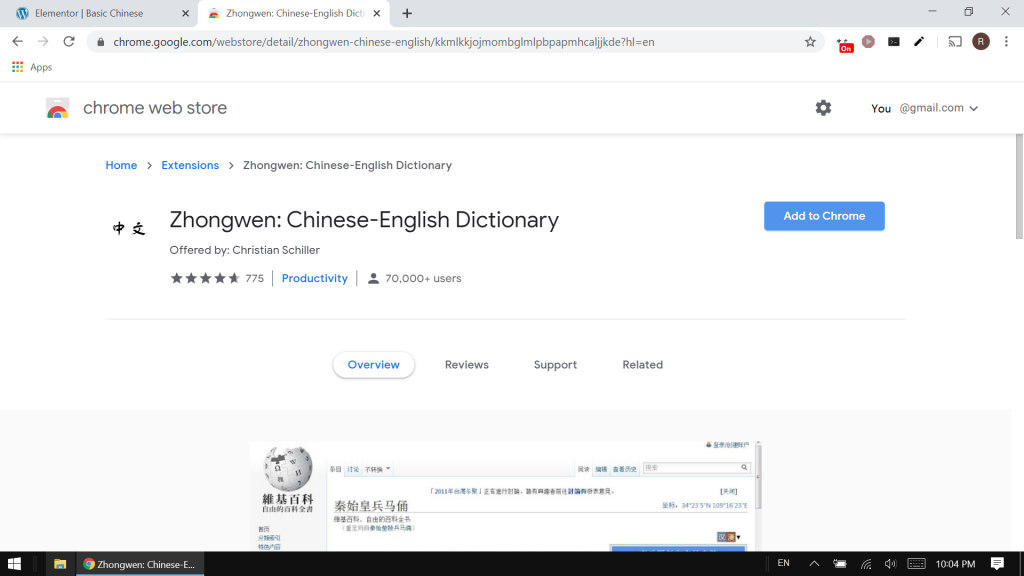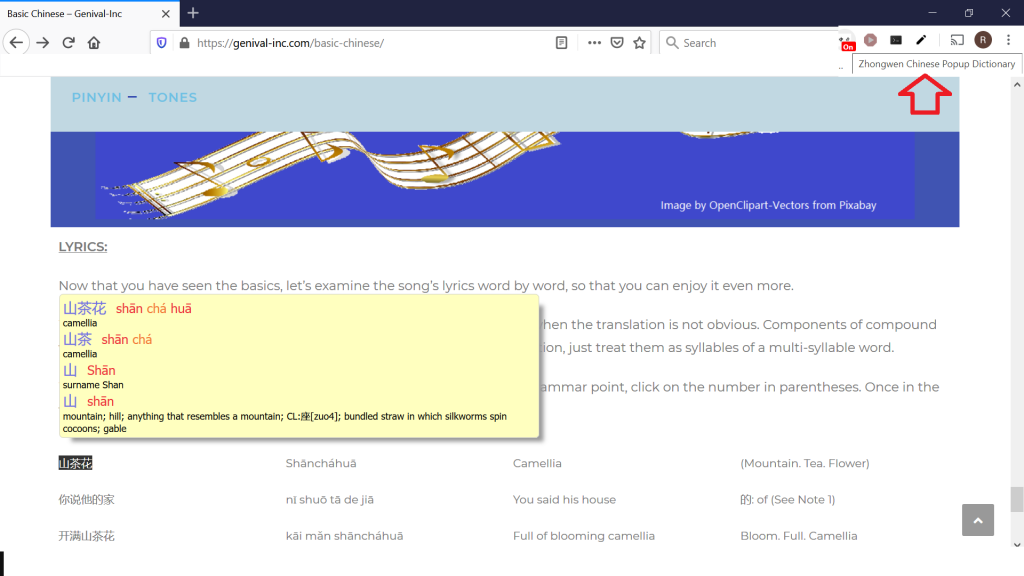Attention: The text -to -speech function may have intermittent issues. If clicking on the “PLAY” button does not produce audio, please let us know (in the Comment section below), if clicking on the button a second time does not produce audio, click on another button, then come back to the first one, or refresh the page.
LEARN CHINESE IN ONE SONG
Through the words of a song we will help you make sense out of the tones and the jungle of dashes and dots that Chinese writing appears to foreigners, so that you can enjoy other beautiful songs like this one, or continue further studies on your own.
Can I learn Chinese through songs? Yes, and very pleasantly so.

The rhyme and rhythm of songs make it easier to remember words, even if you don’t fully understand their meanings.
No need to read Chinese to be able to sing, many songs have Roman transliteration (Pinyin). It has tonal accents, but no need to worry about them in music, you just follow the notes.
That will help you overcome the first major obstacle in learning Chinese: Memorizing the sounds and tones.
The second major obstacle is the writing system, but we’ll deal with it later.
So, let’s start having some fun singing along the video by reading aloud the Pinyin lines.
This song is the most famous Chinese folk song, it has been performed by many famous international artists, such as Kenny G, Celine Dion, the First Lady of China Peng Liyuan, etc. (links included). It has been sung in Italian opera, Hollywood movies, Olympic games, even as China’s National Anthem for a time.
The English subtitle will help you get an idea what the words are about, but it’s not a word-by-word translation, because such translation wouldn’t sound very natural. For word-by-word translation, jump to “LYRICS”.

Let’s start right away with how to pronounce Chinese words and write Chinese characters.
Details will be explained in the “Pinyin”, “Tones” and “Writing System” Sections, which you can access directly by clicking the corresponding keywords in the Index Bar above, but for now, let’s get a quick taste.
We’ll use the first line of the lyrics: 好 一 朵 美丽 的 茉莉花 and explain it word by word.
The natural sounding English translation is something like: “So beautiful Jasmine Flower”, but that’s not exactly the actual words. Let’s look at them one by one:
好 normally means “Good” but it also means “Very” (similar to English “A good amount” is “A large, generous amount”). It’s pronounced “Hǎo”, something like “Ha” “Oh”, with a tonal accent; the inverted hat sign indicates it should be pronounced by starting with a neutral tone, then dropping your voice, then raising your voice again. It sounds intimidating, but click on the Play button next to the character to listen, and you’ll find out it’s not so hard.
To remember the sound, remember the Chinese greeting “Nǐ hǎo” (literally “You Good”).
The 好 character is a stick shape drawing of a woman and a child; it’s a word put together by meaning: “women are good to children”. See the animated GIF image on the right to see how to “draw” it.
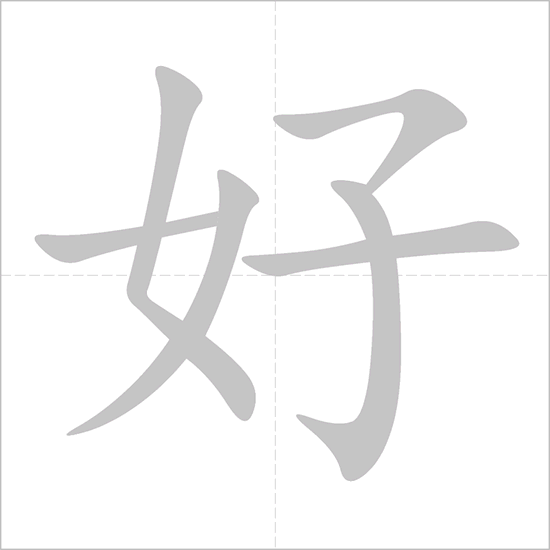
The next character “一” is a really easy one.
一 means “One” and is pronounced “Yī“, with the “i” sounding like “ee”. The flat sign over the “i” indicates it should be pronounced with a flat, normal tone (Click on the character to listen).
To remember the sound, think about the first sound human babies can make: “ee”.
The character is self-explanatory, watch the GIF image to see how to write it.

The next character is 朵. It’s a “measure word”. Chinese has “measuring units” for most things, for example flowers are counted in 朵, similar to English’s “A loaf of bread”, instead of “a bread”. 朵 is pronounced “duǒ” (do +oh + tonal accent). Click to listen.
There is no mnemonic to help remember the sound, you just have to memorize it.
The character is a stick diagram of a tree, 木, with something above it.
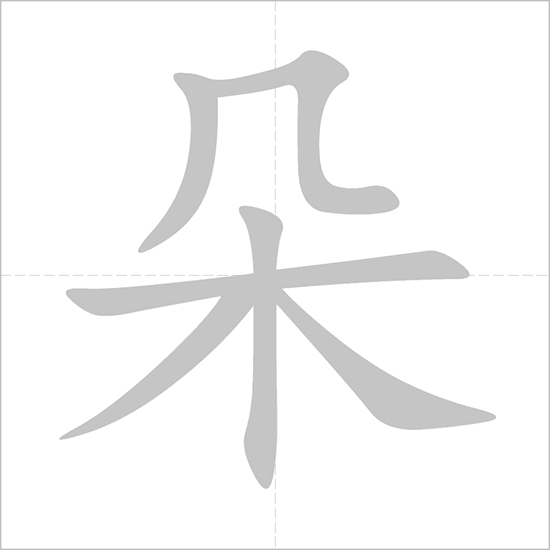
The next character is 花. It means “Flower” and is pronounced “huā”, like “who””ah”. You already know what the flat bar over the “a” is for.
To remember the sound, think of Huawei, the phone company. It’s not exactly the same “Hua”, but it sounds similar, and its logo looks like a flower.
The character is a combination of the 艹 (Grass) character, plus the 亻(Person) and the 匕 (dagger) characters. Grass is somewhat related to flower, but what do a person and a dagger have to do with it? Well, this is a two-level combination, the 亻 and the 匕 characters put together ( 化) means “To transform, to change” and is pronounced “Huà” (the downward slanted bar means it’s pronounced with the dropping tone, from normal to low- Click to listen).
With a bit of imagination, you can picture a person wearing dagger (some kind of official) can be one who makes changes.
“Huà” gives the sound, and 艹 gives the meaning. That’s the idea the scholar came up with to represent “Flower”, and now we have to live with it.
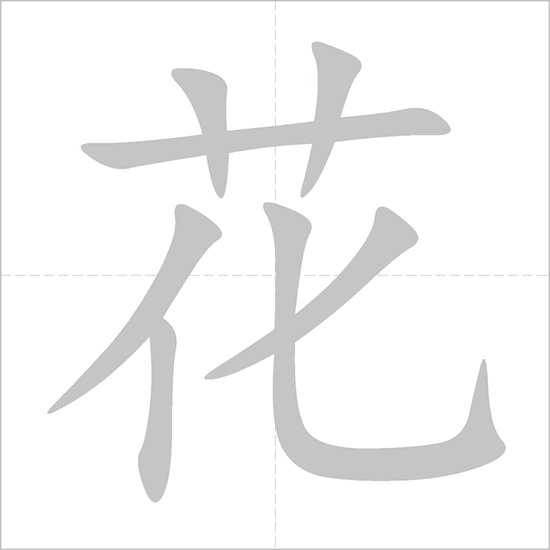

美 means “Beautiful” and is pronounced “měi” (meh + ee + Accent).
There is no mnemonic for the sound “měi”. It may help to know that the US is called “Měiguó” (Beautiful Country) in Chinese.
The character is a combination of the characters for sheep 羊 and big 大 . In Chinese some fat things are considered beautiful. With a bit of imagination, you can picture a “ram” in this stylized diagram 羊 (4 feet, 2 ears, one tail and 2 horns), and “big” in this one 大 (person with stretched arms).
The next character 丽 (lì), also means beautiful. The compound word 美 丽 (měilì) also means beautiful. Chinese language contains many compound words made of two similarly meaning words like this one.
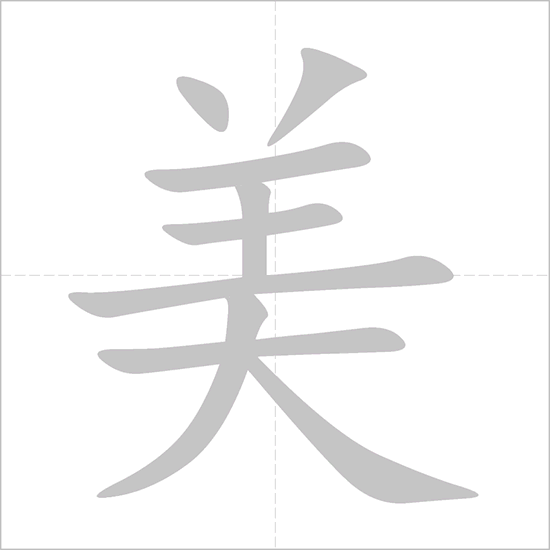
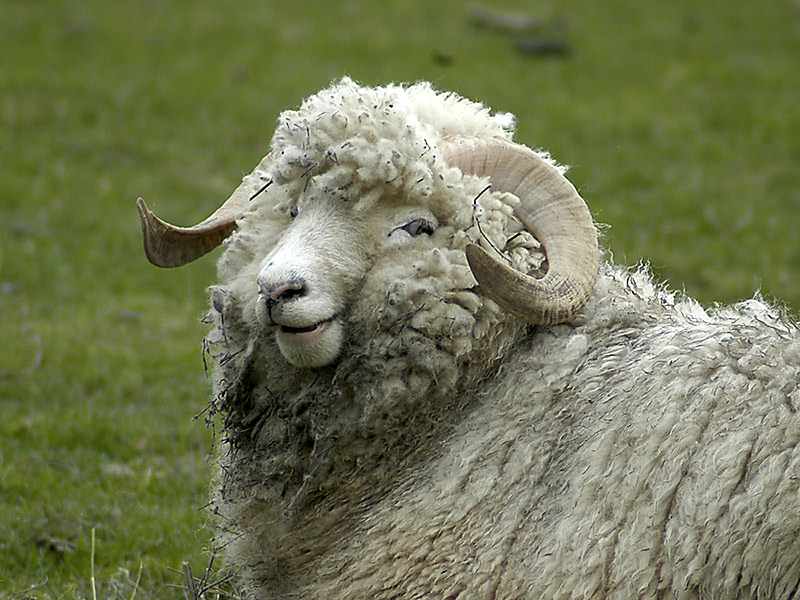
That’s roughly the idea of how Chinese words are pronounced, written and compounded. Please see the Lyrics Section below to get the word-by-word translations for the rest of the song.
Details about the Roman transliteration (Pinyin), rules for proper writing the characters, grammar, etc. can be accessed at anytime by clicking on the corresponding keywords in the Index Bar at the top.

Only the most relevant meaning of each word is provided. Install the “Zhongwen Chinese Popup Dictionary” Extension for Google Chrome or Firefox to see all the meanings.
(For instructions and additional notes on the use of the Table Click here)
Click on this thumbnail on the right to play the song while you’re scrolling the text. If it stops, click play again.
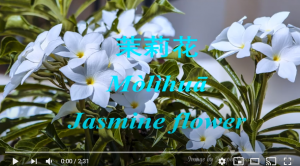
Lyrics
Literal translation and word definition
Grammar, Mnemonics (when useful)
好一朵美丽的茉莉花
Hǎo yī duǒ měilì de mòlìhuā
So beautiful jasmine flower
好 Very 一 One 朵 (Measure word- not translated) 美丽 Beautiful 的 (auxiliary – not translated) 茉莉花 jasmine flower
美 Beautiful 丽 Beautiful (repeating compound word)
茉 (meaningless word) 莉 (a type of grass) 花 Flower (Compound words are often made of words that have meanings that reinforce each other or clarify the compounded meaning, but in this case, some words are meaningless, much like “wa” and “ter” in “water”).
This sentence structure is similar to saying “Very one-that-stands-out person” instead of “Very outstanding person”. 一朵美丽 literally means “A flower beautiful” and is the adjective between the adverb “好” (Very) and the noun 茉莉花 (Jasmine flower). It’s difficult to follow but it’s very common in Chinese.
朵 is a “measure word”, similar to “loaf” in “a loaf of bread” (instead of “one bread”). Measure words are much more common in Chinese than in English.
的 normally means “of” like in “a friend of mine”, but it’s not necessary to translate it in this sentence.
Mnemonics:
See “Quick Start” Section
芬芳美丽满枝桠
fēnfāng měilì mǎn zhīyā
Sweet smelling, pretty, plentiful
芬 Sweet smell 芳 Sweet smell 美 Beautiful 丽 Beautiful 满 Full 枝 Branch 桠 Fork of a tree
芬芳 Sweet smelling
美丽 Beautiful
满 Full
枝桠 Branch, twig.
Once again, these are examples of compound words that are made up of similar-meaning words, a common occurrence in Chinese.
Chinese noun, adjective, adverb and verb are often written the same. 芬 is sweet smell, sweet smelling 美 is Beauty, beautify, etc. They don’t vary according to tense, mode, gender either.
“Full branch” is translated as “Plentiful” here because it sounds better
又香又白人人夸
yòu xiāng yòu bái rén rén kuā
So fragrant, so white, so admired
又 Again, both 香 Fragrant 又 Again, both 白 White 人 Person 人 Person 夸 Praise
人人 The repetition is used here to mean “many persons”
The literal translation is “And fragrant, and white, many people praise”
Mnemonics:
香 (Fragrant) is composed of the characters for Grain 禾 and Sun 日. Wheat grains under the sun smells good.
Grain 禾, in turn, is the character for a Tree 木, with something at its top.
白 Is the character for Sun 日, with a dot. Sun light is White.
人 Was originally a stick drawing of a person, but it has been simplified over time.
让我来将你摘下
Ràng wǒ lái jiāng nǐ zhāi xià
Let me carry you down
让 Let 我 me, I 来 Come 将 Take 你 You 摘 Pluck 下 Down
摘下 To pick (fruit)
Literally: “Let me come pluck you”. But that doesn’t sound very poetic.
我 is I, me, mine. The writing is the same for subject, object and possessive pronouns in Chinese.
送给别人家
Sòng gěi biérén jiā
Give to someone else
送 Offer a present 给 Give 别 Other 人 Person 家 Family, Person
送给 Offer a present
别人 Other people
家 means Family, house, but it’s also respectful way to say “person”.
Literally: “Offer to other people”. But that doesn’t sound very poetic.
送 is a special, elegant Chinese word that means “To offer a present”, “To see someone off”.
给 means “To give”, but is often used as auxiliary verb, in conjunction with other verbs that means “to give”, “to turn over” something.
For example: 让我给您介绍 John. Let me introduce John to you (the verb is 介绍 – introduce, and 给 is the auxiliary)
Mnemonics: 家 is the combination of the characters for Roof 宀and Pig 豕. A Pig in the house implies a household, family.
茉莉花呀茉莉花
mòlìhuā ya mòlìhuā
Jasmine flower, oh jasmine flower
茉莉花 Jasmine flower 呀 Oh! 茉莉花 Jasmine Flower
Links for famous renditions of this song
Section Marker – Pinyin

Pinyin is the Roman transliteration of Chinese sounds. You can read it practically like reading English words that are borrowed from Latin languages, pronouncing “A” like “AH”, “E” like in “De Gaule”, “I” like “EE” (sometimes as somewhere between “EE” and “E”), “O” like “OH”, “U” like in “OO”, “Ü” like in “Huge”.
The Roman alphabet does not have letters that can adequately reproduce some Chinese sounds. Additional “consonants” and “vowels” were created to cover the whole range of Chinese sounds. These are called “Initials” and “Finals”; some examples of words in the lyrics are listed below. For the complete list, visit the Yellow Bridge site.
Ai – as in 来 “Lái” (Come).
Ao – as in 好 “Hǎo” (Good).
Ei – as in 美 “měi” (Beautiful).
Ou – as in 又 “yòu” (And, Both).
C – as in 村 “Cūn” (Village).
Q – as in 七 “qī” (Seven).
J – as in 纪 “Jì” (Discipline)
Zh – as in 摘 “zhāi” (Pluck)
(Note: 的 is pronounced like in “De Gaule” normally, but also like “Dee” in some regions and in the song)
Section Marker – Tones
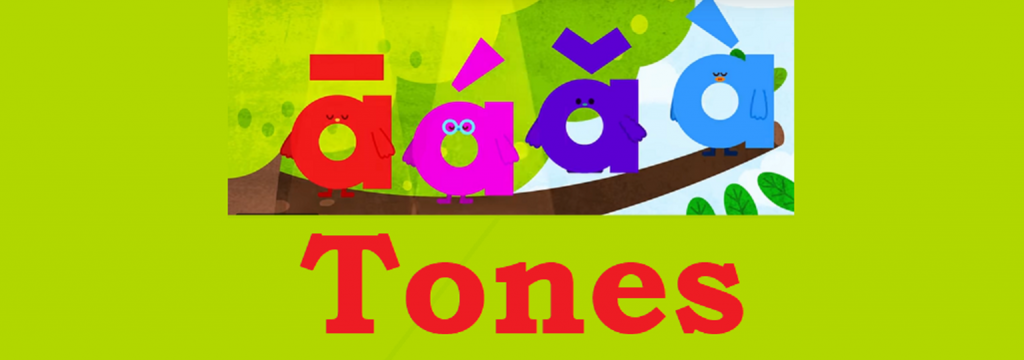
The difficulty with tones is an issue in Pinyin only, in Chinese, the characters are different for different words, hence no confusion there.
Many languages use several syllables to make a word, and changing one syllable in the word changes its entire meaning, for example: Revolution and Resolution.
Many Chinese words have the same basic sounds but are pronounced at different heights on the tone scale, picture that as adding an extra syllable.
It’s easier to remember the tones if you don’t memorize Chinese by its Pinyin writing, instead try to remember the object or concept that the word represents, or the Chinese character.
For example, try to picture “Mother” when you hear 妈 (Mā), “Hemp” when you hear 麻 (Má) and a “horse” when you hear 马 (mǎ). Or invent some mnemonics, such as 妈 is always steady (flat tone), 麻 grows up (rising tone), horses jump down and up (dropping then rising tone).
There are 4 tones: Flat, rising, dropping- then- rising, and dropping. Here are some examples (click on the Chinese characters to listen):
Flat tone:
摘 “zhāi” (Pluck)
Rising tone:
来 “Lái” (Come).
Dropping then Rising tone:
好 “Hǎo” (Good).
Dropping tone:
又 “yòu” (And, Both).
The above video is a song to practice tones. Try it (Pay attention only to the tones of the letter a, and ignore the rest for now).
Notes: There are also words with no tonal accent; if the word is by itself, it’s pronounced with a flat tone, but more briefly than one with the accent over it. If it’s the second character of a compound word, it’s pronounced as if it had a dropping tone.
Some words change tones depending on their use, even if they mean the same thing and are written the exact same way, like 的 (see Grammar Wiki for details)
As already mentioned, the most pleasant way to acquire vocabulary is by watching songs with subtitles, including those in English with Chinese subtitles, like this one.
We will produce more word-by-word translations of the lyrics in the near future, to assist you.
Section Marker – Writing

Many Chinese characters (but not all) were pictographs of physical objects, but they have been stylized many times in the past. The characters are now written using standard “strokes” (See Strokes Section) which makes the original shapes difficult to recognize most of the times.
For example: The evolution of the character “Eye” 目 (Mù)

Simple characters are assembled together to make more complex or abstract characters, by different methods:
Meaning-Meaning combination:
女 is “Woman” (pictogram of a woman)
子 is “Child” (pictogram of a child with arms spread out).
好 is “Good” (Women are good to children).
Meaning-Sound Combination:
妈 (mā – Mother) is composed of 女 (woman – for meaning) and 马 (Mǎ – Horse), for the sound (not the exact sound, but close enough).
Can I start by learning to write the characters of the alphabet?
It’s not necessarily easier the start with the “alphabet” (or radicals), some of its characters are quite complex, but beginners can start with characters that have few strokes and are easy- to- remember pictographs, like those listed below, and their combinations.
Jump to the Strokes Section and watch the videos, to see how the characters are written on touchscreen devices (like smart phones).
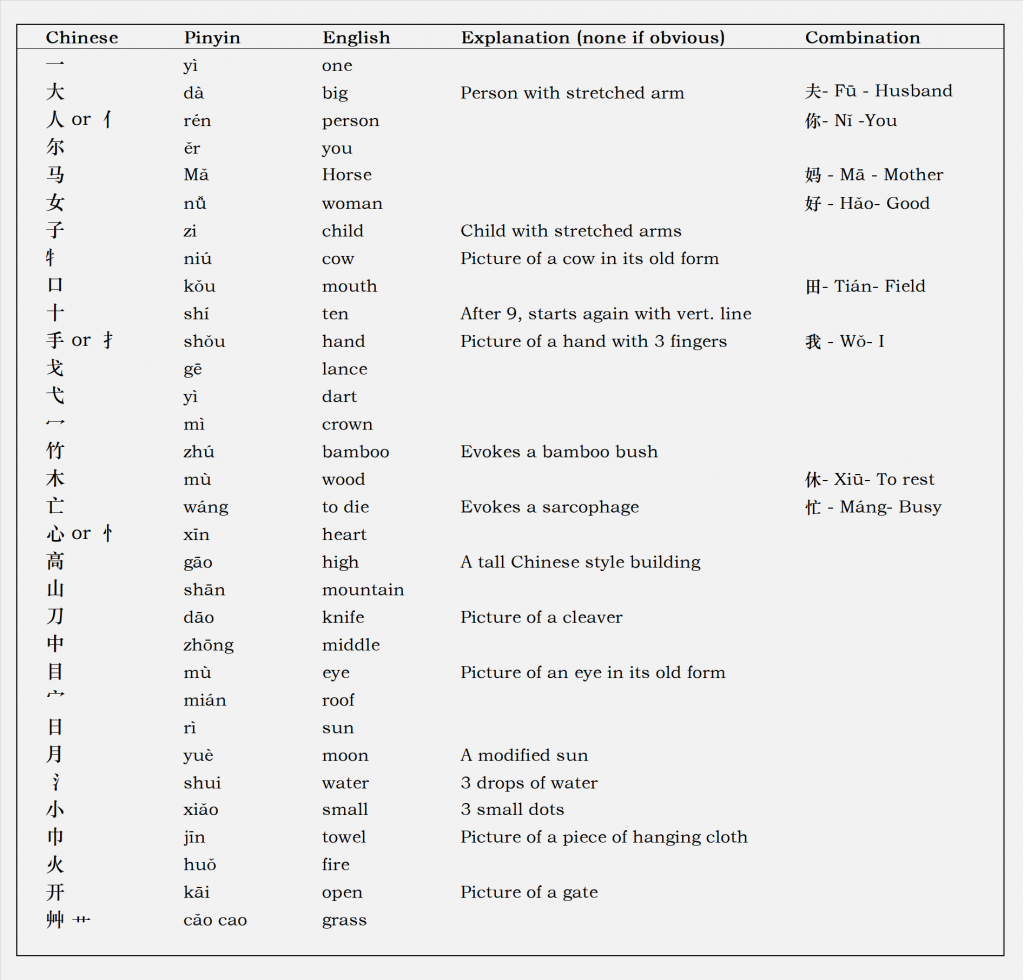
The book “Reading and Writing Chinese”, by William McNaughton and published by Charles E. Tuttle Company is a very good reference; it starts from one-stroke characters then progresses to multiple-stroke ones.
For more on Etymology, or character decomposition, enter the words in the Yellow Bridge online dictionary then click on the Etymology tab.
A note on some of the characters in the Lyrics table.
艹Cao – Grass, 亻Rén – Person (also written 人), 木 Mù – Tree, 也 Yě Also, 白Bái White, 冖Mì Roof, 豕 Shǐ Pig are called Radicals.
They are semantic indicators, for examples: characters with the 艹 radical are related to botany, vegetation. They are also used to order characters in dictionaries. There are 214 radicals, for more on the subject, visit Wikipedia
Section Marker Mnemonics

There are mnemonics books to help memorize the combinations, such as the “Henshall Kanji Mnemonics“
This book is for Japanese, but many characters are the same as Chinese. Here is an extract and explanations; the meaning of the Chinese word is underlined in red in the mnemonic, the words underlined in blue are the components of the character, words that are not underlined are mnemonics
How to read the Henshall Mnemonics:
“一” is the character for “one”. The mnemonic says “ONE finger”, “one” is the meaning, and “finger” is because the character looks like a finger.
“右” is the character for “right hand”. The mnemonic says “RIGHT HAND to the mouth”, because the second component is the character for mouth (口).
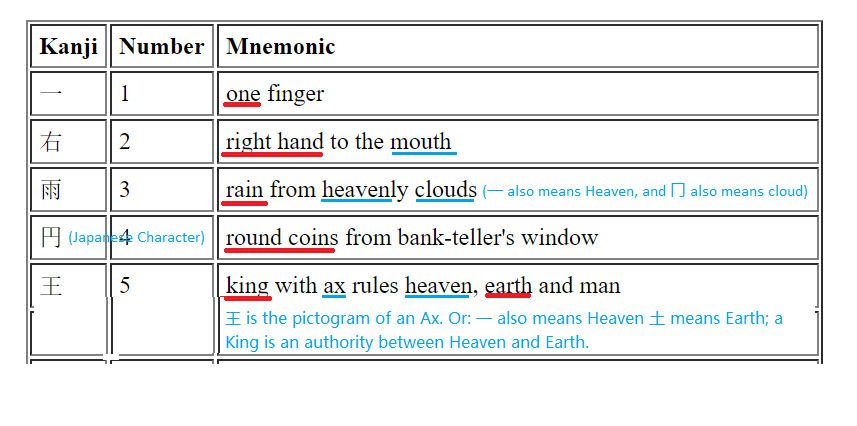
Another useful book of mnemonics is: STICK – Mnemonics for 1600 Chinese simplified characters Kindle Edition – by Melanie Schmidt – Sold by Amazon.
Compound words
Many Chinese words are compound words (usually of two), sometimes the compound word’s meaning is related to either or both of the components, sometimes not; very often the two components have the same meanings; they reinforce each other.
Examples of compound words from the song’s lyrics:
美丽 – měilì – Beautiful (美 Beautiful 丽 Beautiful)
芬芳 – fēnfāng – Sweet smelling (芬 Sweet smelling 芳 Sweet smelling)
The above compound words are relatively easy to understand for English speakers. However, there are also words like this one:
到处 – Dàochù – Everywhere
The meanings of the two components seem to be unrelated to that of the compound word they form ( 到: Arrive, 处: Place). That happens very often. Don’t waste your effort trying to make sense of the combination, just treat them as multi-syllable words, the elements are probably borrowed for their sounds, not their meanings.
It’s the same as in English: “Engle” + “Land” = “England” is an understandable combination, but “wa”+”ter” = “water” is not very evident.
A Chinese character can have many unrelated meanings in English, as in the example below, it depends on what other character it is paired with, or the context.
服: Clothes, wear, take (medicine), serve, be convinced, obey, admit, persuade, be accustomed to.
It is impossible to remember all the meanings of each word. In fact, don’t try to. Rather, memorize the compound words in which the character is found.
Section Marker- Strokes

Stroke types:
There are some 30 types of stroke that are used to write Chinese characters, made up from simple strokes. They are listed in this table.
Every stroke in the table counts as “one stroke”, even if it twists and turns (because it can be written without lifting the pen).
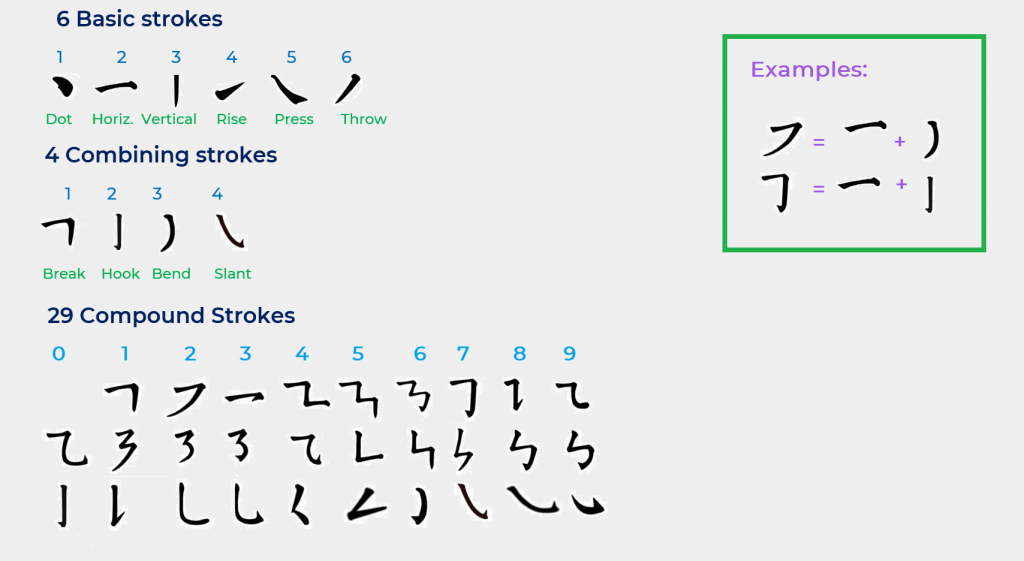
The Basic Strokes can be used alone, the Combining Strokes are used only in combination with other strokes. The 29 Strokes are made up by combining the other two types.
The character 永 (Yǒng – Forever) contains all the basic strokes. The picture shows the Chinese names of the strokes, along with their writing orders and directions.
But, no need to worry. You don’t need to memorize all these strokes to write Chinese into electronic dictionaries, as you can see in the section about handwriting on touchscreen devices below.
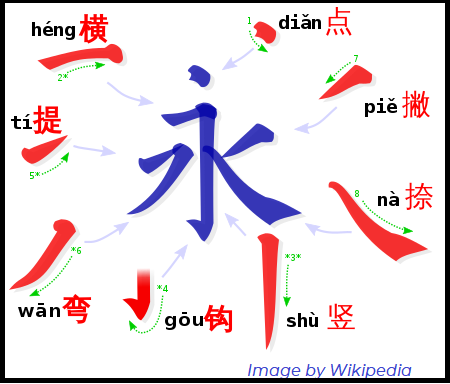
Stroke positions and order:
Proper Chinese writing requires that the strokes are positioned correctly within a grid, and written in correct order.
Online dictionaries are quite tolerant with these 2 requirements, but they may not be able to recognize some characters if these rules are not followed.
The pictures below show an example of stroke position and order. The general order is: Top to bottom, left to right, horizontal stroke before vertical one, but there are many exceptions. Like other things with Chinese language, it’s better to memorize each character.
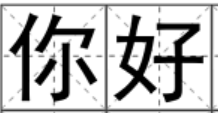
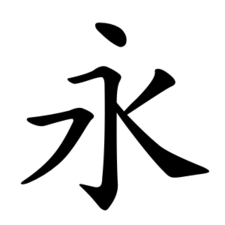
Radicals
There is a kind of “Chinese alphabet” called “Radicals”. There are 214 radicals and they are used to order Chinese characters in dictionaries.
But it’s not really helpful to memorize the radicals. To learn more about them, visit Wikipedia .
Classification order in Chinese dictionaries
Words in Chinese dictionaries can be ordered by 3 different methods:
- By stroke count (one stroke character first)
- By radicals (Radical #1 first)
- By alphabetical order of Pinyin.
Section Marker- Grammar

One good news is Chinese sentence structure is similar to English, with the adjective often preceding the noun. Sometimes a whole phrase is used as adjective, and that could be confusing, but you will get used to it. Chinese also have some sentence structures that are unfamiliar to English speakers, such as the formulation with 把, which puts the object before the verb . See more about 把 sentences in the Lyrics Section.
Another good news is Chinese does not have conjugation, plural, feminine, etc. The characters remain the same all the times.
Rather than explaining the grammar here, we will do it with examples, when you read the song’s lyrics.
You can learn more advanced grammar in GrammarWiki , or many Youtube videos, like this one from “Chinese Zero to Hero“.
Section Marker Further Studies

There are thousands of courses on the web and Youtube, you can browse for yourself.
We suggest you have a close look at the series “Growing up with Chinese”. It’s produced by China’s State TV network CCTV and animated by Charlotte MacInnis, an American born Chinese actress. Her English and Chinese are flawless, which is very pleasant, compared to other courses whose animators are often fluent in only one of the languages.
The series is made like a TV series, its characters go though different activities which are parts of Chinese life, and their dialogues progress in difficulty as the series moves along. It has 100 episodes.
It covers dialogue, vocabulary and grammar; in addition, it also covers cultural insights. Even if you don’t wish to spend that much energy studying Chinese, just the cultural insights are worth watching the series for.
CCTV no longer broadcasts the series, but you can watch third parties’ uploads, like this one, which shows lesson 1.
We will publish on this site shortly the annotated texts of the dialogues, arranged in a format similar to the song lyrics, with proper English translation, word-by-word translation, and grammar point.
Have a look at lesson 1
Click to access Lesson Texts
Dictionaries
There are also thousands of online dictionaries.
We use the following:
- Pleco Chinese Dictionary (for smartphones and tablets, both Android and iOS). The basic version of the app is free, and is sufficient for beginners. It gives English definition, Pinyin, compound words, examples of sentences, components of each character, stroke order, etc. ; for a modest fee, you can get the paid version with additional features, such as flashcards.
- Google Translate. It also gives Pinyin, English translation and compound words. However, it’s not as good as Pleco.
- YellowBridge.com Dictionary. It’s free (with advertisement). In addition to all the above, it also gives etymology.
Grammar
There are also thousands of online grammar sites and Youtube Channels.
We use mostly Grammar Wiki.
Subtitled songs
We will publish more songs along with annotated lyrics, on this site. Here are some songs with easy to understand lyrics, that are available now:
- You Are a Song Within My Heart- 你是我心内的一首歌 Leehom Wang – Selina
- Camellia 山茶花 by Teresa Teng.
- How did you say? 你怎么说 by Teresa Teng 邓丽君
- The Moon Represents My Heart –月亮代表我的心 – Teresa Teng
Plus the songs we upload to our Youtube channel, next to the featured song of the chapter, such as:
的快乐就是想你. My happiness is missing you. Mi fecilidad es extrañarte
桃花雨 – Peach Blossom Rain – Llúvia de flores de durazno
三生石上一滴泪. Tear drop on the Three- Life Stone
ADDITIONAL NOTES
Writing Chinese using touchscreens
Writing Chinese using touchscreen is relatively easy; most software is very tolerant of errors in stroke order and positions most of the time, but not always.
Watch the videos to see how to install the apps and enter handwriting on Android smartphones and on Google Translate.
Yellow Bridge Dictionary
If you wish to learn to write the characters in the table, copy and paste them into the Yellow Bridge dictionary, and watch the stroke orders there. Alternatively, you can install the Pleco app on your smart phone, then enter characters in English or Pinyin to watch the stroke orders, or you can try entering the characters in handwriting yourself.
Note about the Yellow Bridge Dictionary: On their homepage, click on the menu button, then “Dictionary” to start. After pasting your character, the stroke order GIF will play by itself, click on the little brush to replay.
How to install the Zhongwen Popup Dictionary:
Search for “Zhongwen Chinese Popup Dictionary” Extension in Google Chrome or Firefox (left picture), then click on “Add to Chrome (or Firefox)”. This extension gives you the English translation of each character and compound word when you hover over them with the mouse (Right Picture).
Click on the thumbnails to see enlarged pictures, then click on the X on the top right corner of the picture to return here – Do not click the Back Navigation Arrow.
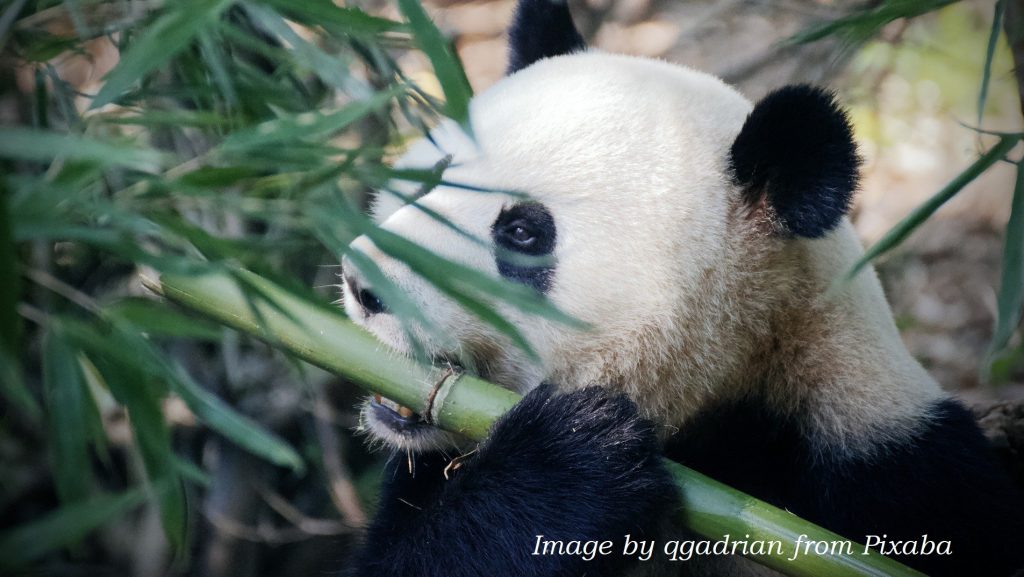
It’s the end of this Chapter. Thank you for checking us out. We hope you have enjoyed it.
Please come back and check our site, we will add more materials soon.

Section Marker Comments
We’d love to hear from you, please send us your comments, suggestions, or inquiries below:
(If you wish to submit more than one comments, please re-access our site by clicking here)

